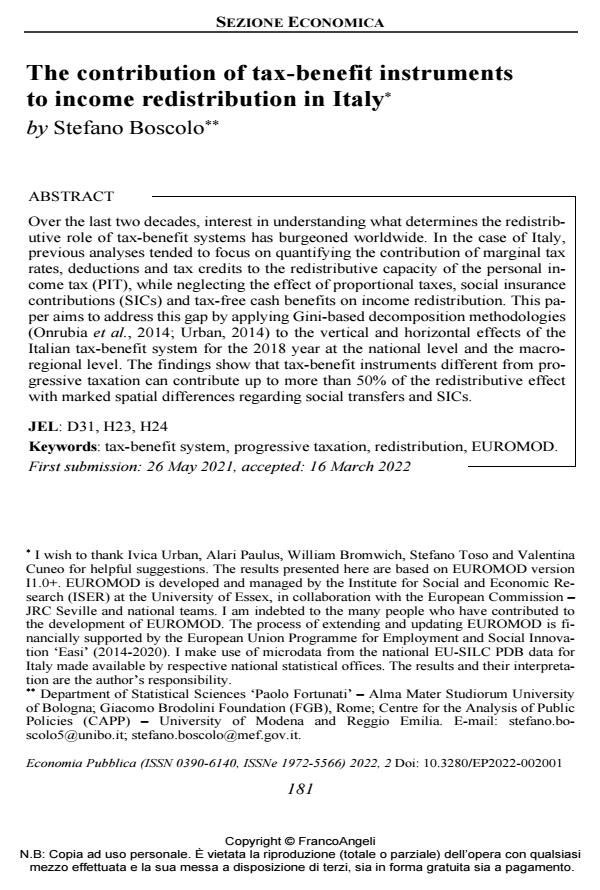The contribution of tax-benefit instruments to income redistribution in Italy
Titolo Rivista ECONOMIA PUBBLICA
Autori/Curatori Stefano Boscolo
Anno di pubblicazione 2022 Fascicolo 2022/2
Lingua Inglese Numero pagine 51 P. 181-231 Dimensione file 2028 KB
DOI 10.3280/EP2022-002001
Il DOI è il codice a barre della proprietà intellettuale: per saperne di più
clicca qui
Qui sotto puoi vedere in anteprima la prima pagina di questo articolo.
Se questo articolo ti interessa, lo puoi acquistare (e scaricare in formato pdf) seguendo le facili indicazioni per acquistare il download credit. Acquista Download Credits per scaricare questo Articolo in formato PDF

FrancoAngeli è membro della Publishers International Linking Association, Inc (PILA)associazione indipendente e non profit per facilitare (attraverso i servizi tecnologici implementati da CrossRef.org) l’accesso degli studiosi ai contenuti digitali nelle pubblicazioni professionali e scientifiche
Over the last two decades, interest in understanding what determines the redistributive role of tax-benefit systems has burgeoned worldwide. In the case of Italy, previous analyses tended to focus on quantifying the contribution of marginal tax rates, deductions and tax credits to the redistributive capacity of the personal income tax (PIT), while neglecting the effect of proportional taxes, social insurance contributions (SICs) and tax-free cash benefits on income redistribution. This paper aims to address this gap by applying Gini-based decomposition methodologies (Onrubia et al., 2014; Urban, 2014) to the vertical and horizontal effects of the Italian tax-benefit system for the 2018 year at the national level and the macroregional level. The findings show that tax-benefit instruments different from progressive taxation can contribute up to more than 50% of the redistributive effect with marked spatial differences regarding social transfers and SICs.
Parole chiave:tax-benefit system, progressive taxation, redistribution, EUROMOD
Jel codes:D31, H23, H24
- The Italian Treasury Dynamic Microsimulation Model (T-DYMM): Data, Structure and Baseline Results Riccardo Conti, Michele Bavaro, Stefano Boscolo, Elena Fabrizi, Chiara Puccioni, Ottavio Ricchi, Simone Tedeschi, in SSRN Electronic Journal /2023
DOI: 10.2139/ssrn.4546893
Stefano Boscolo, The contribution of tax-benefit instruments to income redistribution in Italy in "ECONOMIA PUBBLICA " 2/2022, pp 181-231, DOI: 10.3280/EP2022-002001